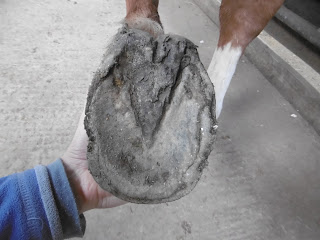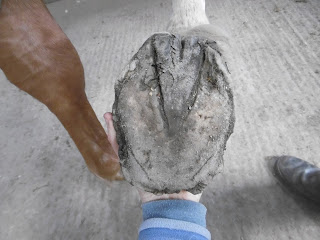Caymen has been here 2 weeks and his initial photos sparked a flurry of interest, particularly from farriers.
I have posted his comparison photos now because there are already changes taking place and because his feet are a good illustration of why we rehabilitate horses in the way we do.
Given that the heart bar shoe was intended to provide palmar support, its interesting to see that the foot is, if anything, better supported now than it was in shoes and the shots of the caudal hoof further on in this post confirm this.
These sole shots compare the foot in shoes on arrival and immediately out of shoes. One of the reasons I dislike bar shoes (and pads, for that matter) is that the sole and frog don't get the stimulus they need for health.
The photo above shows the foot straight out of shoes and below is the same foot 2 weeks later. Even after such a short time I think most people would agree that the foot is already looking better.
The 2 photos below to me show quite clearly that the palmar foot is actually weaker in bar shoes and can become rapidly stronger out of shoes if carefully rehabilitated.
The hairline is more level now, the digital cushion is more developed and the hoof is broadening rather than contracting as it was in bar shoes. Most importantly - the proof of the pudding - he is landing better than he was in shoes.
You can compare the rest of Caymen's photos throughout this post (the shod photo shows him on arrival and the lower photo is him 2 weeks into rehab) but as remedial farriery tends to give rise to strong opinions, I want to make some other points as well.
The vast majority - more than 90% - of the horses who come here for rehab have a diagnosis of navicular bone damage and/or (when MRI has been performed) related soft tissue damage (deep flexor tendon, impar or collateral ligament damage) - damage to the internal structures of the palmar hoof. I'm going to call this a "navicular" diagnosis elsewhere in this post to save time.
The typical veterinary prescription which has been tried on a "navicular" horse before coming here is a combination of drug therapy (often steroid injections, Osphos or Tildren) and remedial farriery; depending on the severity of the damage the prognosis is normally that the lameness, if it has improved at all, is likely to be recurrent.
As a result, most of the horses who come here have had remedial farriery in some form or another. Some arrive still in shoes, others arrive with shoes recently removed; once or twice there has been a horse who has never been shod, though that's very rare. I don't have a say in which shoes (if any) have been used.
My only criteria is that the vet agrees to the horse coming here and horses have not been shod or trimmed in the 3 weeks before their arrival. Provided the owner agrees, I give the background, where I have it, in the horse's write-up on this blog.
Naturally, one blog post can give rise to dozens of different opinions. Several farriers took issue with Caymen's shoes and seemed to think he should be shod differently. Equally, we've had horses arrive shod with wedges and pads or natural balance shoes which also have their supporters and detractors. Other people comment on horses who arrive unshod and suggest they might benefit from shoes.
To give you a feel for the different opinions on remedial shoes, a recent veterinary article on treatment options following a "navicular" diagnosis ("Current concepts of navicular syndrome: diagnosis and treatment" Coomer, Thomas and McKane) stated that "egg bar shoes are contraindicated" and favoured using heart bar shoes with pads. In a rebuttal of the same article another group of vets stated that in their experience central support shoes (such as heart bars) could "greatly increase lameness" whereas egg bar shoes could be beneficial. Clearly further research is needed, as the saying goes.
In the face of such widely divergent opinions on remedial farriery, amongst both vets and farriers, it's impossible to describe a particular remedial shoe as right or wrong. When I post photos and describe the feet of the horses who arrive here it is just that - a description: a benchmark from which to measure change. I am not criticising the vet, the owner, the farrier or the trimmer. In each case it's safe to assume they have done their best for the horse with the best of intentions.
I am simply illustrating an alternative - whether to remedial farriery or the unshod management the owner has tried so far - because one thing is for sure: horses arrived here with feet - whether shod or unshod - that need to change and improve or they would not be coming here in the first place.
I can understand that it's frustrating to see a horse arrive here poorly shod and that farriers want to suggest improvements. I can understand why a farrier might be uncomfortable if he sees a horse he has shod himself improve during rehab. I can understand that a treatment which one vet and farrier believe is a good prescription for a "navicular" horse may be anathema to a different vet and farrier.That's just human nature but whatever has gone on previously is not particularly relevant to the horse's ongoing rehab here.
Realistically, if remedial farriery had worked for my own "navicular" horses in the past I would never have discovered rehabilitation barefoot. It's the same for the rehab horses who come here. My own experience of remedial farriery for "navicular" has been remarkably consistent: that horses improve for a short time and then the lameness recurs in a weaker foot. As an aside, I suspect this is why "navicular" has traditionally been described as a degenerative condition, as I have blogged before.
It's also my experience that the fastest way to improve weak feet is to rehabilitate them out of shoes - which is of course why we do that here - and that using barefoot rehabilitation provides by far the best chance for the horse to remain in work for the long term, minimising the chance of the "navicular" damage recurring or degenerating.
It's also my experience that the fastest way to improve weak feet is to rehabilitate them out of shoes - which is of course why we do that here - and that using barefoot rehabilitation provides by far the best chance for the horse to remain in work for the long term, minimising the chance of the "navicular" damage recurring or degenerating.
The problem is that many (not all) vets and farriers don't have experience of horses working hard without shoes and therefore think that shoes are a prerequisite for performance. In addition, most vets and farriers are taught that remedial farriery (of some kind) is the best option for a horse with a "navicular" diagnosis even though they view the prognosis as degenerative.
One of the key aims of this blog has always been to show that there are alternatives and that owners have choices; that horses can perform to a high level without shoes and that there are options when shoes can't keep a horse sound even - perhaps especially - for horses who have been diagnosed with "navicular".
Remedial farriery has its place but, not surprisingly, horses who come here usually do so because the shoes have not worked.
With the horses here we see feet routinely and repeatedly improve out of shoes. You only have to go through past blog posts, photos and videos and read our rehab results to see this.
So - despite having a "navicular" diagnosis - not only can soundness and hoof integrity improve during rehabilitation barefoot but (as I posted yesterday) it is possible for horses to stay sound and in full work for year after year. Of course rehab and barefoot are not for everyone; it can be hard work and it takes a lot of commitment but the owners I talk to feel that it is worth it.
This is the alternative that owners (and ideally vets and farriers) need to be aware of and its one of the fundamental reasons for this blog.
It's understandable that this will sometimes make some vets, farriers and even trimmers uncomfortable but that's not my intention it's just an unfortunate side effect.
























3 comments:
I don't suppose anyone has a copy of "Current concepts of navicular syndrome: diagnosis and treatment"? This was written by my vets. If not I could ask them and I'm sure they'd give me a copy. My 7yr old girl is now 2 months out of shoes following an MRI confirmed navicular diagnosis. Suggested treatment was Osphos and remedial shoeing. I chose to take her barefoot and although not vets first choice of treatment I have to say they are supporting me so it would be interesting to read their article.
Thanks
p.s. I have to say I love reading your blogs. Gives me hope for my girl.
I was sent a copy by a final year veterinary student as it is on their course but I am sure you can find it online, probably on Google scholar.
This is exceptionally well written! What a lovely post, I look forward to reading more :).
Post a Comment